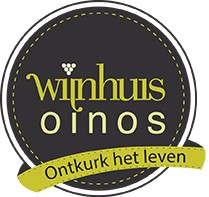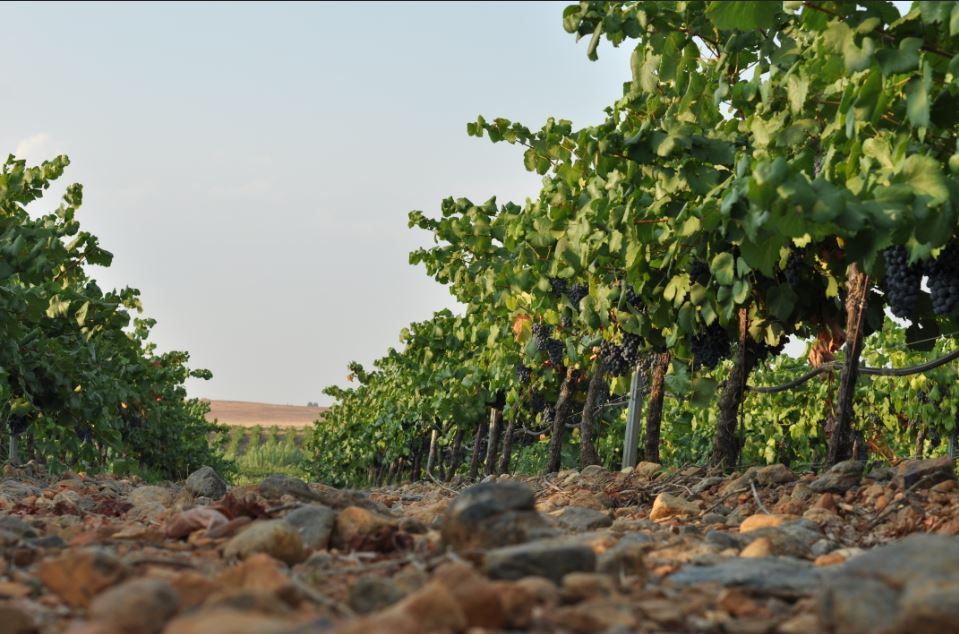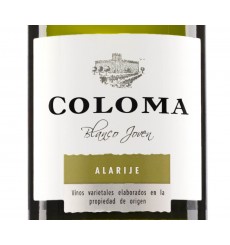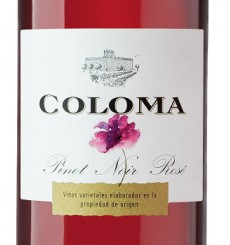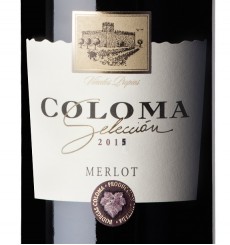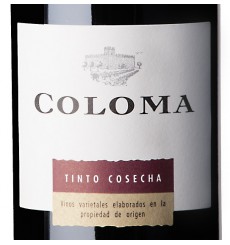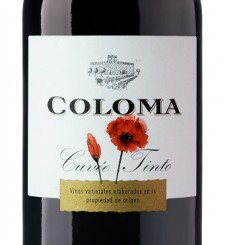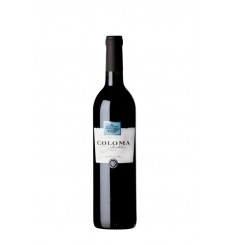Coloma Vinedos y bodegas
Coloma is gelegen binnen Extremadura, net tegen Portugal.
In 1966 richtte José Felix Coloma de gelijknamige bodega op, pal aan de Portugese grens. Zijn eigen vader had ook al een bodega in het noorden van Spanje. Hij ging op zoek naar een warmere plek met stenen in de grond en gunstige klimatologische omstandigheden. Zo kwam hij in Extramadura terecht. Net zoals iedere bodega had hij een wijnkelder gemaakt om de wijnen in te bewaren, maar die liepen onder water. In navolging van wijnboeren in de Loire kwam hij op het idee om daarom een kasteel te bouwen. De muren zijn van graniet en 1,5 m dik en een wilde wingerd beschermt het tegen de hitte in de zomer. De binnentemperatuur is constant in de winter en zomer.
Inmiddels hebben zijn drie kinderen het bedrijf overgenomen: sinds 1997 is Amelia de wijnmaakster (bij de beste 40 vrouwelijke wijnmaaksters van Europa) en verantwoordelijk voor de wijngaarden en het werk in de bodega. Op haar negende wist ze al hoe ze het suikergehalte van druiven moest meten. Ze wordt bijgestaan door wijnmaker Pedro Cuadrado. Helena is de manager, Felix ondersteunt de export.
Wijnmaakster Amelia focust zich enerzijds op wijnen van druiven die van oorsprong voorkomen in Extremadura, zoals alarije, pardina, cayetana blanca en garnacha tintorera. Anderzijds richt zij zich op bepaalde druivensoorten die het heel goed doen in Extremadura, zoals graciano, pinot noir en syrah.
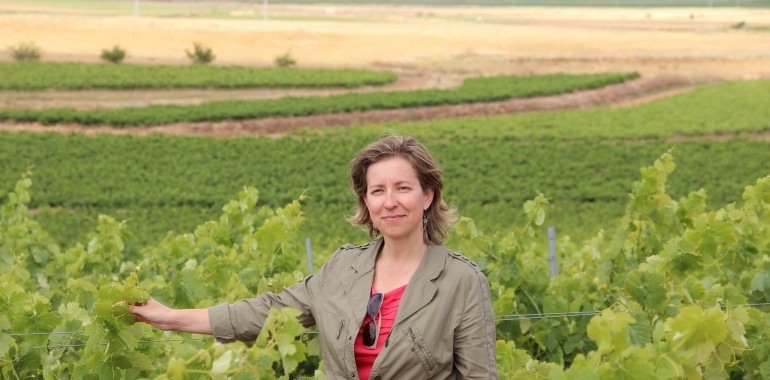
De circa 50 hectare wijngaarden liggen op zo'n 300 meter hoogte. De ondergrond bestaat vooral uit zand, klei en stenen. De stenen zorgen voor een goede isolatie en mineraliteit. Er waait altijd wel een licht briesje afkomstig van de Atlantische Oceaan. Terroir is voor Amelia het belangrijkste, wijn wordt in de wijngaard gemaakt. Het gebruik van hout ziet zij als de finishing touch: 'Houtrijping voor wijn is als make-up voor een vrouw'. Amelia maakt terroirwijnen. De slogan van Coloma luidt dan ook: ‘Wines with soul and soil from the heart of Spain.’
Een interview met Amelia:
-Amelia, in your opinion, are there, so to speak, grapes considered more “manly” such as Cabernet Sauvignon and Tempranillo and also more feminine grapes like Syrah and Merlot?-
-Some critics say so, but you can actually use a “manly” grape to make a “feminine” wine and viceversa. My female friends used to complain about the fact that wines were only made to please men’s palate and asked me to make a wine that would please their taste. I then started to think about which things average women did not like in wine. I realized that most women wanted wine to be soft, velvety, silky, not very tar or tannic, fragrant but not heavy. With these ideas I came up with the conclusion that the best grape I could use for this purpose was Merlot. And that’s how I started to make Coloma Merlot Selección. But this wine not only targets women consumers but young new consumers overall, as they tend to look for more delicate wines.
-Let’s talk about grape varieties.
-My father and I noticed a long time ago that most Spanish regions were trying to emulate the success of Rioja and Ribera del Duero wines by growing Tempranillo grapes. This is not good for diversity and in the end is not good for the export marketing either, since people in India, China and other countries, they all like different style wines, and the best way to achieve this and please everybody, is growing different grape varieties. We grow 11 very different grapes and our harvest lasts from the end of July until the middle of October.
-I hope Extremadura will never make a good Rioja, instead it must create its own signature wines.
-So which grape variety is the favorite in each country?
-The German market appreciates our wines made of Merlot and Garnacha. They like our native clone of Garnacha which is very aromatic, reminding of blackcurrant and raspberry, and some years also blackberry, they also enjoy the deep dark color of the wines made from this grape. By aging the same grape in oak, we have succeeded in the Japanese market, where they love the subtle taste of roasted vanilla and incense of our Garnacha Selección.
-I heard that famous wine guru Robert Parker rated some of your wines…
-It’s true, he got some samples of our Young unoaked Garnacha Roja and rated it 87 points. When wines get over 90 points, then they get sold out very quickly and so did ours.
-Why Spaniards and Europeans are drinking less and less wine and increasingly more soft drinks?
-It’s a sad fact, wine is a drink which requires some learning, and young people have got used to just follow easy global trends. Some families took the wrong behavior of not teaching their sons and daughters how to drink wine responsibly. Some mothers even ask their husbands or parents not to drink in front of their kids, as if it was a wrong thing. As a result, many people have changed a bottle of wine, which is a healthy traditional part of Mediterranean diet for a bottle of coke, which is loaded with unhealthy preservatives, coloring and flavoring chemicals. Studies show that people should not drink more than 330ml of these beverages, yet we all let our kids to pour themselves freely these soft drinks. To make matters worse, we need to endure this unfair traffic campaigns warning against drinking wine…as if wine was the responsible drink for all car accidents. This kind of policy is definitely wrong and has led to a worsening in the healthy conditions of European youth.
-Is it necessary or just pretentious to look, smell, shake, smell again, taste and describe a wine?-
-I think it’s something nice. You can’t do it with other food or drinks. It is elegant and people like to uncork and smell.
-When you order wine in a restaurant, do they serve the wine first to you or your male companion?
– I always say: I taste.
-What will you eat this Chrismas Eve and with which wines?
-As a starter I have decided to serve a Pinot Noir Rosé with salmon and cheese canapés and beef carpaccio. Then we will pair stewed partridge with Garnacha Selección. My sister Helena likes to eat salt-baked Spanish fish with roasted potatoes for Chrismas. Even though it is a fish, we will pair this dish with Merlot wine because the fish has fat and oil.
-What should we do with those bottles of wines we often get as gifts, drink them or keep them until our grandson gets married?
-We all should know that unoaked white and rosé wines should be consumed within 1 or 2 years. If the vintage is 2012, then it should be drunk before 2014. For young reds we should drink them within 2-3 years of production. A Crianza style wine should drink within 4 or 5 years. Reserva around 6 to 8 years and Gran Reserva about 10 years.
Hieronder een video waarin de begeestering blijkt van de familie: https://www.youtube.com/watch?v=Imr9Ok4QF0M
